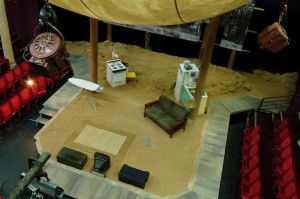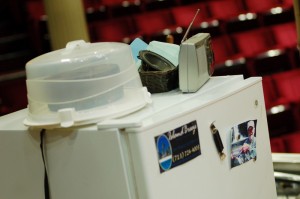The Book of Grace, by Suzan-Lori Parks, closed yesterday here at the Public Theater, so I thought I’d write about some of the props. I’ll start with the set props and some of the tricks that may or may not have been apparent.

This show had a lot of tricks. The iron actually ironed, the stove actually cooked eggs, and the sink actually ran water. Sometimes, the simplest of shows actually have the most complex of prop needs. It becomes less overwhelming if you break it down into simpler parts.
The Stove

The stove was originally a gas stove. In order to make it cook an egg, I took a hot plate apart and placed the burner in place of the original burners. I ran the cord out the back, and it was all run by the light board.
The Fridge

The refrigerator had a radio on top of it, which was played at one point. We needed to sneak a speaker in there somewhere; the fridge was actually from our prop shop, so we didn’t want to drill any holes or cut any parts out of it to hide the speaker. As you can see in the photograph above, by placing it in a basket and surrounding it with old mail and take-out menus, we kept it out of view from the audience.
The Sink
The sink had some of the toughest challenges. Making it run water was the easiest; since the Anspacher Theater has a sink directly backstage, we just needed to run a hose from it under the deck and to the faucet. The tricky part had to do with the end of the scene. The titular book of Grace was torn up by Vet, the father, thrown in the sink, set on fire, and then the charred pieces were pulled out.
The actual book was a custom scrapbook with many parts created and modified by the actress playing Grace. As such, we didn’t want them to tear it up and burn it every night. Second, if we burned an actual book, the ashes would float up and set the ceiling on fire. Finally, there would not be any way to consistently control what the charred pieces looked like after burning the book.

On the top of the photograph, you can see a pocket in the sink. Before tearing up the book, the actor grabbed a duplicate copy, which was similar but simpler. After tearing it up, he dropped the pieces down this pocket. Along the bottom of the picture, you can see a bar of metal which covered a trough filled with campfire gel. This is what the actor set on fire. On the left side of the photograph is another pocket. This one held the pre-charred scraps of paper which the actress pulled out at the end of the play.





